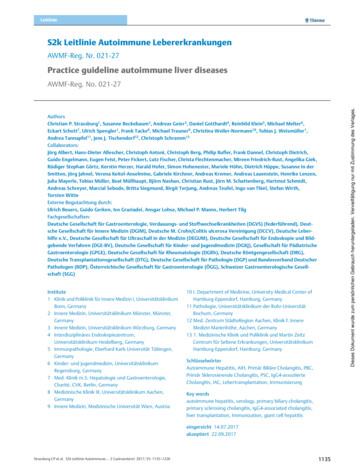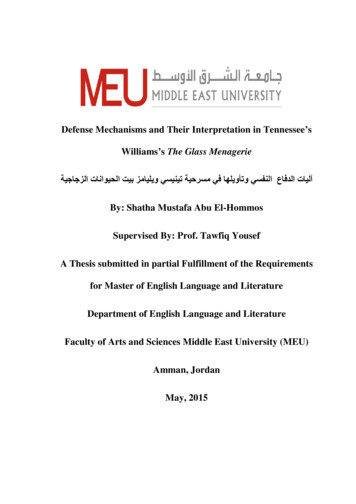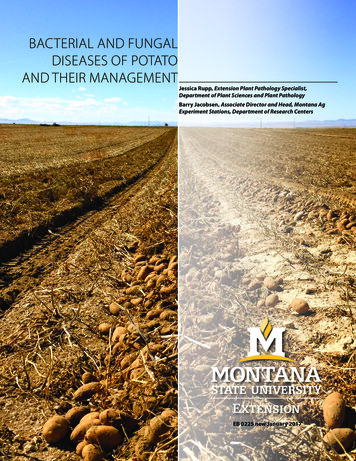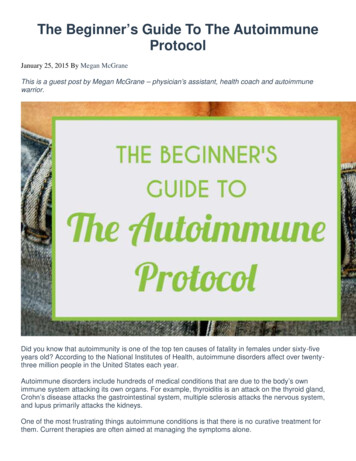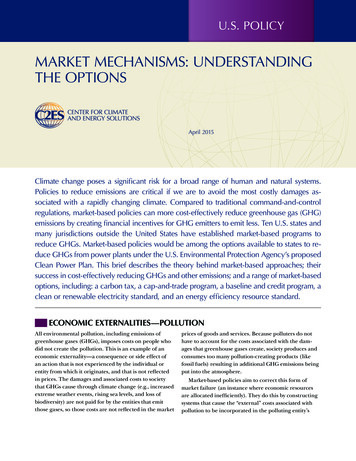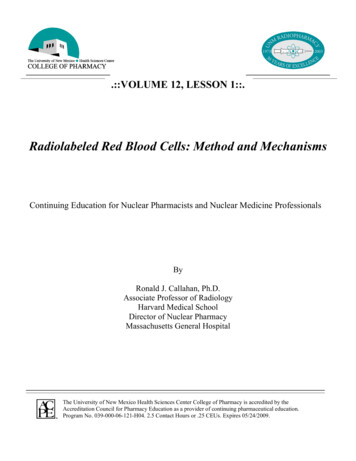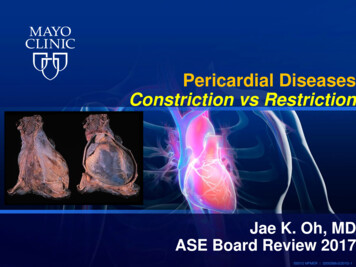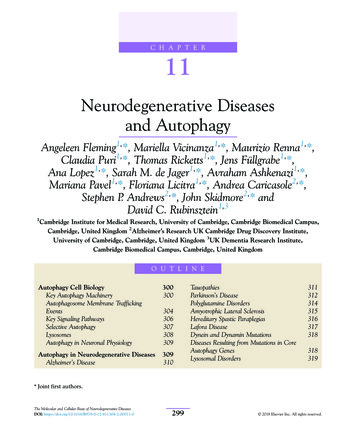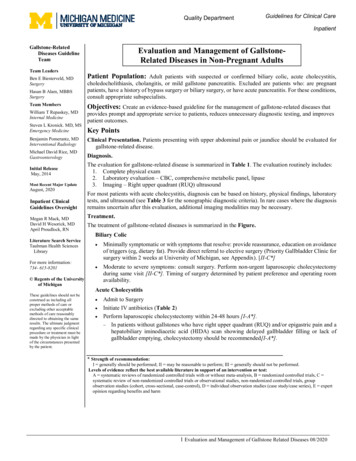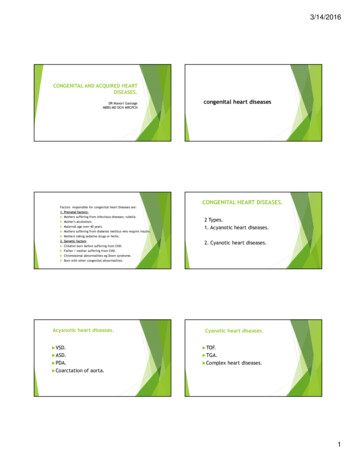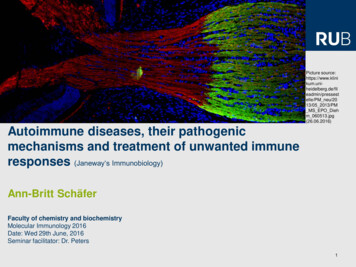
Transcription
Picture dmin/pressestelle/PM neu/2013/05 2013/PMMS EPO Diehm 060513.jpg(26.06.2016)Autoimmune diseases, their pathogenicmechanisms and treatment of unwanted immuneresponses (Janeway‘s Immunobiology)Ann-Britt SchäferFaculty of chemistry and biochemistryMolecular Immunology 2016Date: Wed 29th June, 2016Seminar facilitator: Dr. Peters1
Molecular Immunology 2016Seminar facilitator: Dr. PetersOverview autoimmune diseases and pathogenic mechanisms classification involved components chronic autoimmune diseases mechanisms of tissue/cell damage autoantibodies T cells Treatment of unwanted immune responses drugs biologicsAutoimmune diseases, their pathogenic mechanisms and treatment of unwanted immune responses Ann-Britt Schäfer Bochum 29.06.20162
Molecular Immunology 2016Seminar facilitator: Dr. Petersautoimmune diseases and pathogenic mechanismsgeneral information loss of self tolerance autoimmunity can be provoked: proved by mouse models self proteins are hard to eliminatePicture source: 639.jpg (28.06.2016)Autoimmune diseases, their pathogenic mechanisms and treatment of unwanted immune responses Ann-Britt Schäfer Bochum 29.06.20163
Molecular Immunology 2016Seminar facilitator: Dr. Petersautoimmune diseases and pathogenic mechanismsClassification Organ-specfic: few organs are targeted Systemic: many tissues effected both can become chronical clustering of autoimmune diseases– classification into subtypesOrgan-specific autoimmune diseasesType 1 diabetes mellitusGoodpasture‘s syndromMultiple sclerosisCrohn‘s diseasePsoriasisGraves‘ diseaseHashimoto‘s thyroiditisAutoimmune hemolytic anemiaAutoimmune Addison‘s diseaseVitiligoMyasthenia gravisSystemic autoimmune diseasesRheumatoid arthritisSclerodermaSystemic lupus erythematosusPrimary Sjögren‘s syndromePolymyositisAutoimmune diseases, their pathogenic mechanisms and treatment of unwanted immune responses Ann-Britt Schäfer Bochum 29.06.2016Picturesource:Murphy,Kenneth;Janeway;8th Edition;p.6234
Molecular Immunology 2016Seminar facilitator: Dr. Petersautoimmune diseases and pathogenic mechanismsClassification Organ-specfic: few organs are targeted Systemic: many tissues effected both can become chronical clustering of autoimmune diseases– classification into subtypes exceptions:– inflamatory bowel disease (IBD)– autoimmune hemolytic anemiaOrgan-specific autoimmune diseasesType 1 diabetes mellitusGoodpasture‘s syndromMultiple sclerosisCrohn‘s diseasePsoriasisGraves‘ diseaseHashimoto‘s thyroiditisAutoimmune hemolytic anemiaAutoimmune Addison‘s diseaseVitiligoMyasthenia gravisSystemic autoimmune diseasesRheumatoid arthritisSclerodermaSystemic lupus erythematosusPrimary Sjögren‘s syndromePolymyositisAutoimmune diseases, their pathogenic mechanisms and treatment of unwanted immune responses Ann-Britt Schäfer Bochum 29.06.2016Picturesource:Murphy,Kenneth;Janeway;8th Edition;p.6235
Molecular Immunology 2016Seminar facilitator: Dr. Petersautoimmune diseases and pathogenic mechanismsinvolved components autoantibodies (e.g. myastenia gravis)– recognize: acetylcholine receptors– damage: muscle weaknessPicture source:Murphy,Kenneth;Janeway; 8thEdition; p.625Autoimmune diseases, their pathogenic mechanisms and treatment of unwanted immune responses Ann-Britt Schäfer Bochum 29.06.20166
Molecular Immunology 2016Seminar facilitator: Dr. Petersautoimmune diseases and pathogenic mechanismsinvolved components autoantibodies (e.g. myastenia gravis) antibodies as immune complexes– complement activation and ligation ofFc-receptors– damage: inflammation of tissuePicture source:Murphy,Kenneth;Janeway; 8thEdition; p.625Autoimmune diseases, their pathogenic mechanisms and treatment of unwanted immune responses Ann-Britt Schäfer Bochum 29.06.20167
Molecular Immunology 2016Seminar facilitator: Dr. Petersautoimmune diseases and pathogenic mechanismsinvolved components effector T cells (e.g. type 1 diabetes)– recognize: self peptides of commensal microbiota with self-MHC– damage: local inflammation or dircet tissue damagePicture source: Murphy, Kenneth; Janeway; 8th Edition; p.626Autoimmune diseases, their pathogenic mechanisms and treatment of unwanted immune responses Ann-Britt Schäfer Bochum 29.06.20168
Molecular Immunology 2016Seminar facilitator: Dr. Petersautoimmune diseases and pathogenic mechanismsinvolved components pregnancy– IgG can crossplacenta– maternal IgG iscatabolized– can cause chronicorgan injuryPicture source: Murphy, Kenneth; Janeway; 8 th Edition; p.626Autoimmune diseases, their pathogenic mechanisms and treatment of unwanted immune responses Ann-Britt Schäfer Bochum 29.06.20169
Molecular Immunology 2016Seminar facilitator: Dr. Petersautoimmune diseases and pathogenic mechanismsinvolved componentsPicture source: Murphy, Kenneth; Janeway; 8th Edition; p.627Autoimmune diseases, their pathogenic mechanisms and treatment of unwanted immune responses Ann-Britt Schäfer Bochum 29.06.201610
Molecular Immunology 2016Seminar facilitator: Dr. Petersautoimmune diseases and pathogenic mechanismsinvolved componentsPicture source: Murphy, Kenneth; Janeway; 8th Edition; p.627Autoimmune diseases, their pathogenic mechanisms and treatment of unwanted immune responses Ann-Britt Schäfer Bochum 29.06.201611
Molecular Immunology 2016Seminar facilitator: Dr. Petersautoimmune diseases and pathogenic mechanismschronic autoimmune diseases high number of self antigen– limiting of immune response is hardly possible broken sequestrationPicture source: Murphy, Kenneth; Janeway; 8th Edition; p.628Autoimmune diseases, their pathogenic mechanisms and treatment of unwanted immune responses Ann-Britt Schäfer Bochum 29.06.201612
Molecular Immunology 2016Seminar facilitator: Dr. Petersautoimmune diseases and pathogenic mechanismschronic autoimmune diseases autoimmune responselead to production ofepitopes– reveal crypticepitopes– epitope of antigencan be completlydifferent e.g. SLE– can be linked tothe progress of adisease e.g.pemphigusvulgarisAutoimmune diseases, their pathogenic mechanisms and treatment of unwanted immune responses Ann-Britt Schäfer Bochum 29.06.2016Picturesource:Murphy,Kenneth;Janeway; 8thEdition;p.62813
Molecular Immunology 2016Seminar facilitator: Dr. Petersautoimmune diseases and pathogenic mechanismsMechanisms of tissue/cell damagePicture source: Murphy, Kenneth; Janeway; 8th Edition; p.572Autoimmune diseases, their pathogenic mechanisms and treatment of unwanted immune responses Ann-Britt Schäfer Bochum 29.06.201614
Molecular Immunology 2016Seminar facilitator: Dr. Petersautoimmune diseases and pathogenic mechanismsMechanisms of tissue/cell damagePicture source: Murphy, Kenneth; Janeway; 8th Edition; p.630Autoimmune diseases, their pathogenic mechanisms and treatment of unwanted immune responses Ann-Britt Schäfer Bochum 29.06.201615
Molecular Immunology 2016Seminar facilitator: Dr. Petersautoimmune diseases and pathogenic mechanismsMechanisms of tissue/cell damage Type III aresystemic diseases Type IV are mainlyorgan-specificdiseases most diseases havea more complexresponse e.g. type dition;p.630Autoimmune diseases, their pathogenic mechanisms and treatment of unwanted immune responses Ann-Britt Schäfer Bochum 29.06.201616
Molecular Immunology 2016Seminar facilitator: Dr. Petersautoimmune diseases and pathogenic mechanismsAutoantibodies against blood cells self antigens on blood cellstrigger destruction e.g.autoimmune hemolyticanemia destruction of blood cell inMPS or through lysis lysis of nucleated cells israre but possible e.g.Hashimoto‘s thyroiditis treatment:– removal of spleen– administration of lgGPicture source: Murphy, Kenneth; Janeway; 8 th Edition; p.631Autoimmune diseases, their pathogenic mechanisms and treatment of unwanted immune responses Ann-Britt Schäfer Bochum 29.06.201617
Molecular Immunology 2016Seminar facilitator: Dr. Petersautoimmune diseases and pathogenic mechanismsAutoantibodies against receptors stimulation of receptorthrough antibody bindinge.g. Graves‘ tion;p.633Autoimmune diseases, their pathogenic mechanisms and treatment of unwanted immune responses Ann-Britt Schäfer Bochum 29.06.201618
Molecular Immunology 2016Seminar facilitator: Dr. Petersautoimmune diseases and pathogenic mechanismsAutoantibodies against receptors inhibition of receptor through antibody binding e.g. myasthenia gravis– autoantibodies against α-chain of nicotinic acetylcholine receptors– progressive muscle ition;p.633Autoimmune diseases, their pathogenic mechanisms and treatment of unwanted immune responses Ann-Britt Schäfer Bochum 29.06.201619
Molecular Immunology 2016Seminar facilitator: Dr. Petersautoimmune diseases and pathogenic mechanismsAutoantibodies against extracellular antigens is rare but harmful Goodpasture‘s disease:– antibodies against α3 chain ofbasement membrane collagen ligate Fcγ receptor activation of monocytes,neutrophils, tissue basophils andmast cells release of chemokines influx of neutrophilsPicture ENAL093.jpg(25.06.2016)Autoimmune diseases, their pathogenic mechanisms and treatment of unwanted immune responses Ann-Britt Schäfer Bochum 29.06.201620
Molecular Immunology 2016Seminar facilitator: Dr. Petersautoimmune diseases and pathogenic mechanismsAutoantibodies against extracellular antigens 3 failures in immune complex clearance1. injection of large amounts of antigens large amounts of immune complexes overwhelming system (serum sickness)2. chronic infections incapability of clearing infection– bacterial endocarditis: widespread immune complex injury– mixed essential cryoglobulinemia: deposite immune complexes injoint and tissuesAutoimmune diseases, their pathogenic mechanisms and treatment of unwanted immune responses Ann-Britt Schäfer Bochum 29.06.201621
Molecular Immunology 2016Seminar facilitator: Dr. Petersautoimmune diseases and pathogenic mechanismsAutoantibodies against extracellular antigens3. part of the pathogenesis of SLE 3 types of antigens: nucleosome subunit of chromatin, spliceosomeand small cytoplasmatic ribonucleoprotein complex autoantigens are exposed by dying cells large amounts of immune complexes are produced activation of phagocytic cells more nucleoprotein complexesAutoimmune diseases, their pathogenic mechanisms and treatment of unwanted immune responses Ann-Britt Schäfer Bochum 29.06.201622
Molecular Immunology 2016Seminar facilitator: Dr. Petersautoimmune diseases and pathogenic mechanismsT cells specific for self antigens difficult to prove existence of autoreactive T cells:–T cells recognition is MHC restricted–difficult to identify targeted antigen–antigens recognized by CD4 T cells are easier to identify than thosethat are recognized by CD8 T cellsevidence through diseases like Typ 1 diabetesAutoimmune diseases, their pathogenic mechanisms and treatment of unwanted immune responses Ann-Britt Schäfer Bochum 29.06.201623
Molecular Immunology 2016Seminar facilitator: Dr. Petersautoimmune diseases and pathogenic mechanismsT cells specific for self antigens evidence through diseases like Typ 1 diabetesPicture source: Murphy, Kenneth; Janeway; 8th Edition; p.636Autoimmune diseases, their pathogenic mechanisms and treatment of unwanted immune responses Ann-Britt Schäfer Bochum 29.06.201624
Molecular Immunology 2016Seminar facilitator: Dr. Petersautoimmune diseases and pathogenic mechanismsT cells – Multiple sclerosis T cell mediated chronic neurological disease affected antigens: - myelin basic protein (MBP)- proteolipid protein (PLP)- myelin oligodendrocyteglycoprotein (MOG) development of plaques demyelination of nerve cells inflammatrory infiltration along blood vesselsPicture source: 2/multiple-sclerosis.jpg(25.06.2016) variety of neurological symptomsAutoimmune diseases, their pathogenic mechanisms and treatment of unwanted immune responses Ann-Britt Schäfer Bochum 29.06.201625
Molecular Immunology 2016Seminar facilitator: Dr. Petersautoimmune diseases and pathogenic mechanismsT cells – Multiple sclerosis autoreactive B cells produce with help of T cells autoantibodies againstmyelin antigens demyelinationPicture source: Murphy, Kenneth; Janeway; 8th Edition; p.637Autoimmune diseases, their pathogenic mechanisms and treatment of unwanted immune responses Ann-Britt Schäfer Bochum 29.06.201626
Molecular Immunology 2016Seminar facilitator: Dr. Petersautoimmune diseases and pathogenic mechanismsT cells – Rheumatoid arthritis progressive chronic disease affected tissues: synovium, cartilage and bonePicture source: Murphy, Kenneth; Janeway; 8th Edition; p.638Autoimmune diseases, their pathogenic mechanisms and treatment of unwanted immune responses Ann-Britt Schäfer Bochum 29.06.201627
Molecular Immunology 2016Seminar facilitator: Dr. PetersOverview autoimmune diseases and pathogenic mechanisms classification involved components chronic autoimmune diseases mechanisms of tissue/cell damage autoantibodies T cells Treatment of unwanted immune responses drugs biologicsAutoimmune diseases, their pathogenic mechanisms and treatment of unwanted immune responses Ann-Britt Schäfer Bochum 29.06.201628
Molecular Immunology 2016Seminar facilitator: Dr. PetersTreatment of unwanted immune responsesgeneral information occur inautoimmunedisease,transplantrejection andallergy aim: avoid tissuedamage andprevent disruptionof tissue functionPicture source: Murphy, Kenneth; Janeway; 8th Edition; p.670Autoimmune diseases, the
responses (Janeway‘s Immunobiology) Ann-Britt Schäfer Faculty of chemistry and biochemistry Molecular Immunology 2016 Date: Wed 29th June, 2016 Seminar facilitator: Dr. Peters Picture source: https://www.klini kum.uni-heidelberg.de/fil eadmin/pressest elle/PM_neu/20 13/05_2013/PM _MS_EPO_Dieh m_060513.jpg (26.06.2016) 2 Overview autoimmune diseases and pathogenic
